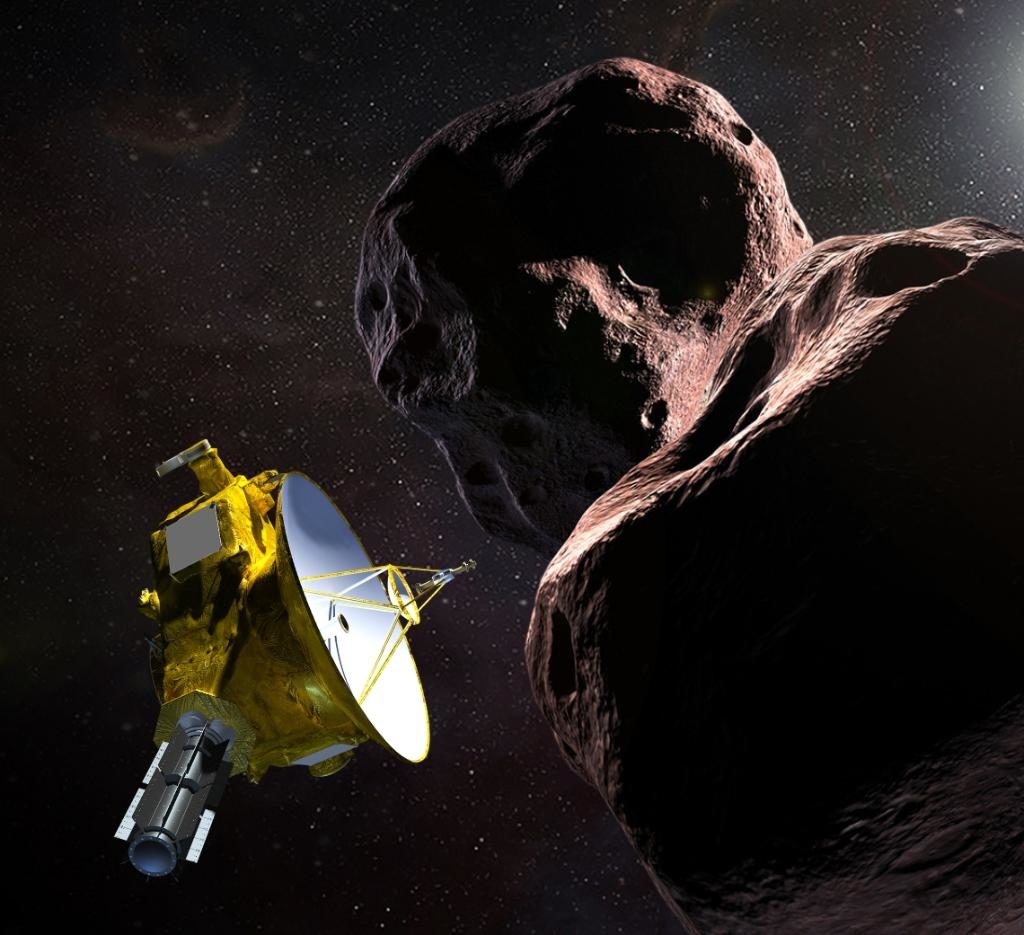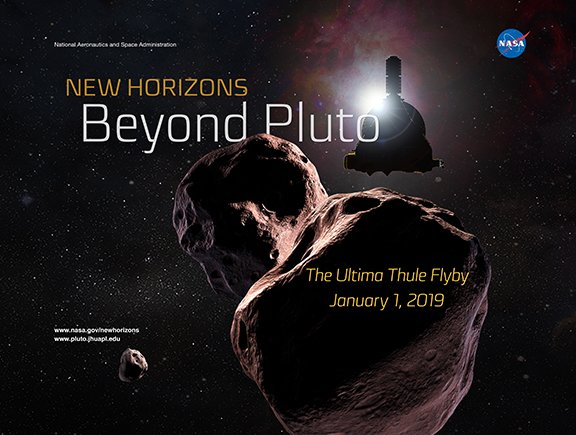RocketSTEM –28 December 2018
JHU APPLIED PHYSICS LABORATORY, MD / KENNEDY SPACE CENTER,
FL – Three Days and Counting !!! All spacecraft systems are ‘GO’ for the New
Year’s Eve Flyby of NASA New Horizons spacecraft past ‘Ultima Thule’ – for
a once in a lifetime encounter with the small icy rock in the Kuiper Belt located some 1 Billion miles
beyond Pluto and 4 Billion miles from the Sun. It counts as the most distant planetary
object ever visited by a spacecraft from Earth!
New Horizons has been hurtling towards the unexplored outer
limits of our Solar System since launching 13 years ago in Jan. 2006 and conducting
the first up close flyby of Pluto – the ninth planet – in July 2015.
Now the missions second flyby at ‘Ultima Thule’ is almost
upon us on New Years Eve.The
name means “beyond the known world” and was chosen after an unofficial naming contest held
earlier this year.
New
Horizons will swoop past ‘Ultima Thule’ at 12:33 a.m. EST on New Year’s Day at a
velocity of 32,000 mph (9 miles per second) at a distance of merely 2,200 miles.
And no one knows what the surface looks like because of the immense distance
from Earth.
That will
all change if all goes well!
No data
will be transmitted during the encounter. Four hours after closest approach the
spacecraft will turn and begins transmitting back the first high priority images
and data.
“Across
the whole team, people are ready, they’re in the game, we can’t wait to go
exploring,” Alan Stern, the New Horizons principal investigator, said at a briefing
today, Dec 28. “It’s been three-and-a-half years [since the Pluto flyby], we’ve
worked so hard, people are ready to see that payoff and see what we can learn
about the birth of our solar system.”
“This flyby of Ultima is a one shot deal on New Years Eve
and New Years Day. There has been nothing like this mission since the Pioneers
and Voyagers. We have been preparing almost
every day for the past 3 ½ years. It very busy because our team is only 10 %
the size of the Voyager team.”
The first high resolution image could be unveiled at a press
briefing on Jan. 2. Traveling at the speed of light across immense distances it
takes more than six hours for signals to reach eagerly waiting scientists on
Earth.
However, because of the nonsensical political impasse in Washington,
D.C. known as the ‘Government Shutdown’ – all systems may not be go with NASA
TV coverage. Only time will tell.
read all the updates on the alternate websites of NASA Live and NASA’s New
Horizons mission partner – the Johns Hopkins University Applied Physics Laboratory (JHU
APL) YouTube channel.
https://www.nasa.gov/nasalive
Space UpClose will also
be on hand and I will be reporting live from JHU APL.
Thus you will not miss
out! – just read below:
From
NASA:
On #NewYearsEve, @NASANewHorizons will perform the most distant planetary flyby ever as it
zooms past an object nicknamed #UltimaThule. Make sure to
follow our partner @JHUAPL for
updates: http://pluto.jhuapl.edu
From JHU APL- in case NASA TV is not available:
Where to Watch:
A schedule of televised events is below; all times EST and
subject to change according to mission timelines and activities. Keep checking
back for updates and additions!
NASA TV and the NASA New Horizons social media
channels are now online. The New Horizons mission will also provide coverage of
live activities on this website and the Johns Hopkins Applied Physics
Laboratory YouTube channel.
https://www.youtube.com/user/jhuapl
for the latest update:
the latest updates on the historic flyby of Ultima Thule, the farthest
exploration of any world, ever: Dec 28 2018.
New Horizons Team Members Principle Investigator Alan Stern – Southwest
Research Institute Mission Operations Manager Alice Bowman – Johns Hopkins
Applied Physics Lab Science Team Co-Investigator Kelsi Singer – Southwest
Research Institute Moderator Mike Buckley – Johns Hopkins Applied Physics Lab
flyby events over the next few days. A detailed summary is at the bottom:
Times Eastern). New Horizons live
events will air on NASA Television. For mission status updates follow @NASANewHorizons.
final approach before flyby of Ultima Thule, a Kuiper belt object (KBO).
3 p.m.: Q&A with the New Horizons Team
8 p.m.: Panel Discussion: New Horizons Flyby of Ultima Thule
belt object.
9:45 a.m.: New Horizons Signal Acquisition from Ultima Thule Flyby
(All Channels)
11:30 a.m.: New Horizons Post-Flyby Press Conference
results from Ultima Thule.
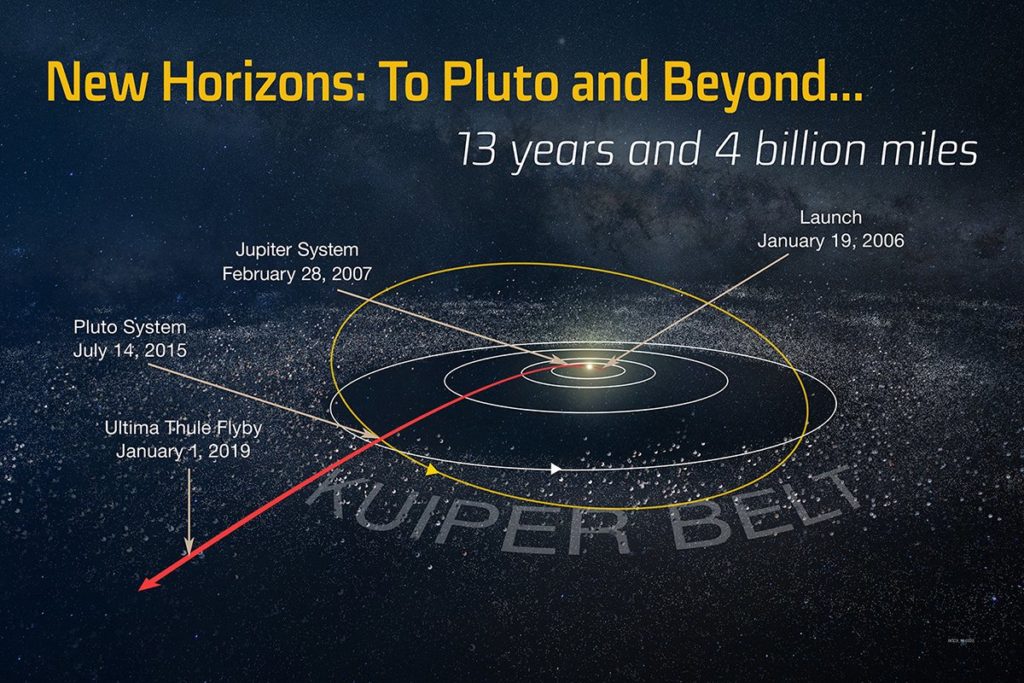 |
|
NASA New Horizons spacecraft trajectory since launching from
Earth on Jan. 19, 2006 on ULA Atlas V rocket. Credit: NASA/JHUAPL/SWRI |
Pluto, the largest known body in the Kuiper
Belt, was the first target explored by New Horizons during a fast flyby over three
years ago during July 2015.
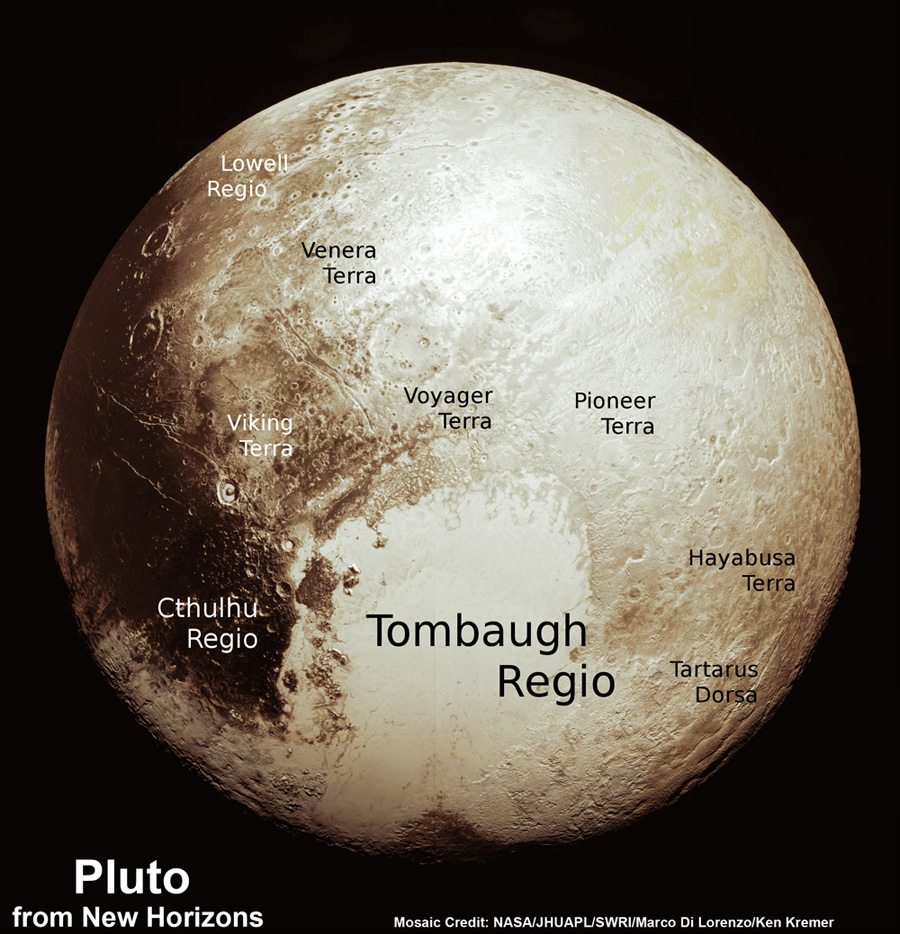 |
|
Global mosaic of Pluto created from raw images gathered
during July 2015 flyby by NASA’s New Horizons spacecraft. Credit: NASA/JHU/JPL/SWRI/Marco Di Lorenzo/Ken Kremer/kenkremer.com |
‘Ultima Thule’ is the second Kuiper Belt object that will be
explored up close by New Horizons.
Thule’ as the nickname for the spacecrafts next flyby target on New Year’s
Day 2019 – “symbolizing this ultimate exploration by
NASA” says Alan Stern, the missions team leader and chief scientist. It orbits
the sun more than 4 Billion miles (6.5 billion
kilometers) beyond
Earth.
frozen world – officially known as 2014 MU69 – will
become the farthest object ever explored up close by a manmade emissary in
history when NASA’s New Horizons spaceship zooms past for a close encounter on Jan. 1, 2019 orbiting more than a billion miles beyond
Pluto, the most distant planet in our Solar System.
first ever up close examination of this distant object holds critical clues to
the formation of the outer solar system eons ago.
chosen “Ultima Thule” (pronounced ultima thoo-lee”) for the Kuiper Belt
object the New Horizons spacecraft will explore on Jan. 1, 2019,” NASA
announced.
a pristine building block of the solar system. It
was ‘ultimately’ selected as the team after being imaged by NASA’s Hubble Space
Telescope for scrutiny by the science team.
distant and tiny.
binary pair, or perhaps a system of multiple objects with multiple moons.
medieval literature and cartography. Ultima Thule means “beyond
Thule”– beyond the borders of the known world—symbolizing the exploration
of the distant Kuiper Belt and Kuiper Belt objects that New Horizons is
performing, something never before done.”
for the Kuiper Belt target besides 2014 MU69 and held a naming contest.
Alan Stern, New Horizons principal investigator from Southwest Research
Institute in Boulder, Colorado, in a statement.
the known worlds, to what will be this mission’s next achievement. Since this
will be the farthest exploration of any object in space in history, I like to
call our flyby target Ultima, for short, symbolizing this ultimate exploration
by NASA and our team.”
team and submitted to the infamous International Astronomical Union (IAU) after
the flyby is completed.
unknown. It could be peanut shaped or binary. Its size is estimated at no more than 20 miles (30 kilometers) long, or, if a
binary, each about 9-12 miles (15-20 kilometers) in diameter.
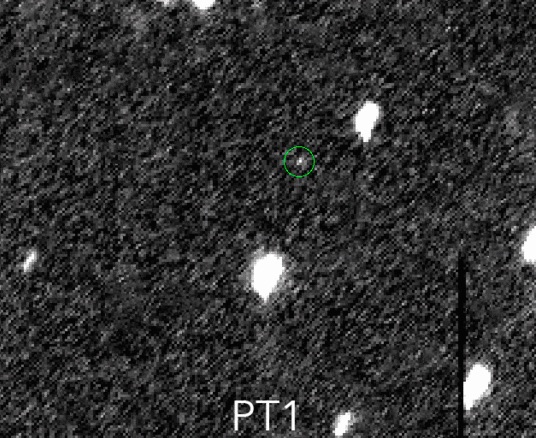 |
|
This image of Ultima Thule, or 2014 MU69, was
captured by the Hubble Space Telescope in 2014. Credit: NASA/JHUAPL/SWRI |
“We really won’t know what
MU69 looks like until we fly past it, or even gain a full understanding of it
until after the encounter,” said New Horizons science team member Marc Buie, of
the Southwest Research Institute, Boulder, Colorado, at the American
Geophysical Union Fall 2017 Meeting in New Orleans. “But even from afar, the
more we examine it, the more interesting and amazing this little world
becomes.”
Year’s Eve and New Year’s Day 2019 will be an exciting sequel to the historic
exploration New Horizons performed at Pluto in 2015,” added Alan Stern, New
Horizons principal investigator from Southwest Research Institute (SwRI) in
Boulder, Colorado. “Nothing even like MU69 has ever been explored before.”
for Ken’s on site reporting about the New Horizons flyby direct from the
Johns Hopkins University Applied Physics Laboratory (JHU APL) in Laurel, MD.
Watch for Ken’s continuing
onsite coverage of NASA, SpaceX, ULA, Boeing, Lockheed Martin, Northrop Grumman
and more space and mission reports direct from the Kennedy Space Center, Cape
Canaveral Air Force Station, Florida and Wallops Flight Facility, Virginia.
and human spaceflight news: www.kenkremer.com –www.spaceupclose.com – twitter
@ken_kremer – email: ken at kenkremer.com
journalist and photographer based in the KSC area.
Ken’s photos are for sale and he is available for lectures and outreach events
| Date | Time | Event |
|---|---|---|
|
28
Friday
December, 2018
|
1:00-1:30 pm EST |
New Horizons: Beyond Pluto. Preview of the spacecraft and science operations during the Ultima Thule flyby.
|
|
31
Monday
December, 2018
|
2:00-3:00 pm EST |
Press briefing: Ultima Thule flyby science and operations preview |
3:00-4:00 pm EST |
Q&A: Ask the New Horizons Team |
|
8:00-11:00 pm EST |
Panel discussion on exploration of small worlds (8-9 pm); Ultima Thule flyby countdown events; mission updates |
|
|
1
Tuesday
January, 2019
|
12:15-12:45 am EST |
Live coverage of countdown to closest approach (12:33 am); real-time flyby simulations |
9:45 – 10:15 am EST |
Live coverage of New Horizons signal-acquisition from Ultima Thule flyby |
|
11:30 am– 12:30 pm EST |
Press briefing: Spacecraft status, latest images and data download schedule |
|
|
2
Wednesday
January, 2019
|
2:00-3:00 pm EST |
Press briefing: Science results from Ultima Thule
|
|
3
Thursday
January, 2019
|
2:00-3:00 pm EST |
Press briefing: Science results from Ultima Thule
|


